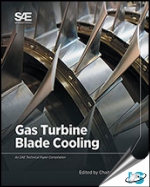Tab Article
Gas turbines play an extremely important role in fulfilling a variety of power needs and are mainly used for power generation and propulsion applications. The performance and efficiency of gas turbine engines are to a large extent dependent on turbine rotor inlet temperatures: typically, the hotter the better.
In gas turbines, the combustion temperature and the fuel efficiency are limited by the heat transfer properties of the turbine blades.
However, in pushing the limits of hot gas temperatures while preventing the melting of blade components in high-pressure turbines, the use of effective cooling technologies is critical.
Increasing the turbine inlet temperature also increases heat transferred to the turbine blade, and it is possible that the operating temperature could reach far above permissible metal temperature. In such cases, insufficient cooling of turbine blades results in excessive thermal stress on the blades causing premature blade failure. This may bring hazards to the engine’s safe operation.
Gas Turbine Blade Cooling, edited by Dr. Chaitanya D. Ghodke, offers 10 handpicked SAE International’s technical papers, which identify key aspects of turbine blade cooling and help readers understand how this process can improve the performance of turbine hardware.


